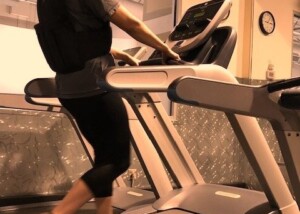Here’s a simple way to reap maximum benefits with a 30 percent incline, which can be achieved only if you do not hold onto the treadmill.
You may think you’re getting an amazing workout by using a 30 percent incline on a treadmill, but if you’re holding onto the machine, you’re cancelling out the effects of this generous slope.
I know what you’re thinking: “How can anyone walk on a 30 percent incline without holding on? They’ll be thrown off!”
Have you not ever walked up a steep hill outdoors? Were you holding onto anything?
And certainly, you’ve walked up flights of stairs countless times without grasping anything for support. Why should an angled treadmill be any different?
If your entire body is leaning back (like a water skier) while you’re holding onto the front bar with straight, locked-out arms at an incline — and you release your hands in that position — then yes, you’ll fly backwards off the machine.
How about standing straight (no leaning back) as you walk, so that your body is vertical?
Reduce the speed so that the tread isn’t whizzing under your feet at such a high incline.
NOW let go. You won’t fall backwards any more than if you were walking outside up a 30 percent hill.
How Not to Fall Off a Treadmill at 30 Percent Incline Without Holding On
Again, keep your body vertical — as you would when walking up a staircase, which is actually angled more steeply than 30 percent.
When you climb a staircase or steep hill outdoors, your body is vertical, which is why you don’t fall backwards.
Apply this practice to a treadmill that’s set at 30 percent slope. Set the speed to 1 mph and start walking with your arms at your sides.
If you’re free of any neurological disorder that impairs balance when walking, you will not fall off at such a slow speed.
At 1 mph, walk 10 minutes at 30 percent incline without your hands making contact with the treadmill.
What seems like a crawl is actually comparable to the pace that you’d choose if hiking in the mountains on a similar grade.

Even WITHOUT the backpack, you probably would NOT exceed 1.5 mph sustained on this angle of a hill — which appears to be close to 30 percent.
Because you’re now vertical, with significant ankle flexion, you should feel the entire backside of your lower legs working.
If you remain vertical while holding on (which would require a continuous pulling against the bar with your hands), this will relieve the work from your legs.
Thus, a vertical body while holding on with a “tugging” grip is NOT the same as a vertical body while walking hands-free. NOT THE SAME!
With your hands off, you may also soon start feeling a burn in your hamstrings,.quads and/or low back, especially if you slightly increase the speed.
All these signs mean that your body is out of condition for high incline walking.
Holding onto the treadmill will not condition it, not in the least, never, even if you’re tugging yourself into a vertical position.
To set the treadmill at 30 percent, speed at 3 mph and THEN hold on is just plain insanity.
Now, if 1 mph proves to be unchallenging, then raise the speed to 1.5 mph and see how five minutes of that goes without holding on. Experiment to find the speed for which you can sustain.
The only way that you’ll gain fitness benefits from 30 percent incline work on a treadmill is if you mimic walking up a same-grade hill outside. And how would you walk outdoors?

Stockfreeimages/Kapu
1) Body vertical
2) Hands not holding onto anything
3) Pronounced hip and knee flexion due to the acute angle formed by your vertical body to the hill before you.
These three features must be duplicated on the treadmill, and the only way to do that is to keep your hands off the machine (except for brief heart rate check or brief, temporary steadying while you adjust the speed, wipe sweat or sip water).
It’s extremely unrealistic to think you can walk a 30 percent incline at 3 mph without holding on.
To sustain this pace hands off requires exceptional cardiovascular and musculoskeletal conditioning. So just because you’re not this advanced doesn’t mean you should hold on!
Instead, go down to 1.5 mph or 1.2 mph or whatever — and let go. If this is too difficult, go down to 1 mph. Remember, you’re at 30 percent incline; you can’t expect to move like a mountain lion.
Using a 30 percent incline without hanging onto the treadmill will force adaptations in your core, hamstrings, calves, Achilles tendon, quadriceps and other muscles.
If you hold on, you’ll be wasting your time. If letting go is too exhausting, you’re going too fast, even if it’s “only” 1.5 mph.
Another Option
“There is a slight learning curve to using a treadmill without holding on,” says Dr. Charles J. Pelitera, assistant professor of kinesiology and coordinator of the Health/Wellness Program at Canisius College, NY.
“This refers to proprioception or knowing where your body is in space. A person who is not in ‘shape’ should be encouraged to not hold on — and they can work on a progressive routine that ‘weans’ them off of holding on.
“Have them start off by trying one minute with hand contact, one minute without, and begin to decrease the hand contact time and increase hands-free time as they progress along. Confidence and consistency play a large role in this.”


 Dr. Pelitera
Dr. Pelitera







































